JQ Magazine: Book Review — ‘The Guest Cat’
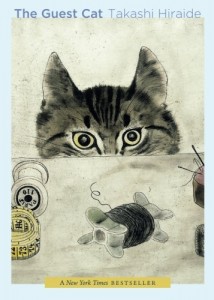
“This is one of many books that you simply cannot judge by its cover. At only 140 pages, The Guest Cat touches on a surprising range of interesting topics, and even if you’re not a cat person you can find a lot to like.” (New Directions)
By Julio Perez Jr. (Kyoto-shi, 2011-13) for JQ magazine. A bibliophile, writer, translator, and graduate from Columbia University, Julio is currently working at Ishikawa Prefecture’s New York office while seeking opportunities with publications in New York. Follow his enthusiasm for Japan, literature, and board gaming on his blog and Twitter @brittlejules.
Born in 1950, Takashi Hiraide is a talented writer across many fields including genre-bending essays and highly acclaimed poetry. His prose novel The Guest Cat (translated by Eric Selland) blends both together to produce a beautiful piece that was released in English last January. It is a winner of Japan’s Kiyama Shohei Literary Award and is a best-seller in France. This is one of many books that you simply cannot judge by its cover. At only 140 pages, it touches on a surprising range of interesting topics and even if you are not a cat person, you can find a lot to like in the book. Even the narrator admits that he does not consider himself a cat lover:
“There are a few cat lovers among my close friends, and I have to admit that there have been moments when that look of excessive sweet affection oozing from around their eyes has left me feeling absolutely disgusted. Having devoted themselves to cats body and soul, they seemed at times utterly indifferent to shame. When I think about it now, rather than my not being a cat lover, it may simply have been that I feel a disconnect with people who were cat lovers. But more than anything, I’d simply never experienced having one around.”
That is not to say that Chibi, the titular guest cat, is not lovable; on the contrary, she charms everyone she meets, but do not pass on this small gem of a book thinking it is simply a chronicle of an owner doting on his pet. It is better considered a story of how a special cat brings light and life into the minds of the humans that are blessed to have her company.
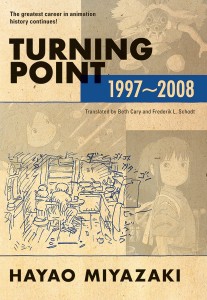
“With wit and humor, Miyazaki offers insight from his long career with every turn of the page. Like an unforgettable sunset or the first time a cooking experiment came out well, he discusses experiences that leave you unexpectedly changed.” (VIZ Media)
By Alexis Agliano Sanborn (Shimane-ken, 2009-11) for JQ magazine. Alexis is a graduate of Harvard University’s Regional Studies—East Asia (RSEA) program, and currently works as an executive assistant at Asia Society in New York City.
I consider myself an aficionado of director and animator Hayao Miyazaki and Studio Ghibli. Having seen his work countless times, visited the museum in Tokyo and done a fair amount of supplemental reading, I figured Turning Point—a collection of Miyazaki interviews and articles spanning 1997 through 2008 and newly translated by Beth Cary and Frederik L. Schodt—would probably be a rehash of the similar. I presumed it would be a book for Japan or anime specialists. On the back cover there’s even a quote from the L.A. Times: “Essential reading for anyone interested in Japanese or Western animation.” However, this statement is entirely too narrow and ultimately misleading.
In fact, the book (which is a sequel to Starting Point: 1979-1996, also translated by Cary and Schodt and now available in paperback) is less about animation and Japan than it is the human condition and those existential questions that keep you awake at night. Miyazaki, at one moment reserved and the other candid, plunges fearlessly into complex, introspective and intellectual issues about human’s relationship with education, child-rearing, philosophy, history, art, environmentalism and war (to name a few).
He does this with a sprinkle of romanticism and a dusting with realism. Using his seemingly continual dissatisfaction with the world, Miyazaki aims to positively spark change and inspire. He insists that his films are not just flights of fancy; rather, he makes them to motivate the next generation to improve the world. “Children learn by experiencing…it is impossible to grow up without being hurt,” he writes. “Experiences like: accepting the duality of human nature, the importance of grit, conviction, and perseverance, and respecting nature and the land….For children willing to start, our films become powerful encouragement.”
JQ Magazine: Concert Review—Yoshiki Classical World Tour Dazzles San Francisco with Surprise X Japan Guest

“The night offered something for everyone in Yoshiki’s ability to merge and bring together different genres and listeners and touch the collective beating heart therein.” (Shirong Gao)
By Shirong Gao (Shiga-ken, 2005-07) for JQ magazine. A member of JETAA Northern California, Shirong is a graphic designer, Illustrator, and breakfast food lover who worked in a Japanese countryside as seen only in Studio Ghibli movies. For more, visit gaoshirong.com.
Every night, as a child drifting off to sleep, I looped a rock ballad. My personal lullaby. A song by multi-million-selling heavy metal band X Japan, the Rising Sun’s answer to KISS. Yet not even in dreams did I see myself growing up to one day meet its leader, Yoshiki, and witness how far he’s come in his career.
A classically trained musician turned rock legend, Yoshiki has now returned to his more refined roots, embarking on a world tour of Yoshiki Classical concerts featuring music from the eponymous solo album released last year in collaboration with talents the likes of Beatles producer Sir George Martin and the London Philharmonic Orchestra.
On April 28, Davies Hall, home to the San Francisco Symphony, was packed on a Monday night to host only the second date of Yoshiki’s tour following its debut in Costa Mesa three days prior. “Definitely a different scene from a typical classical concert,” commented attendee Arisa Takahashi (Nara-ken CIR, 1991-92), who has also performed at the hall as part of the Sing Out, Davies! choral workshop. “There were people with blue hair, dressed in their frilly Lolita finery, sitting alongside classical music attendees.”
JQ Magazine: Book Review—‘Monkey Business Volume 4’
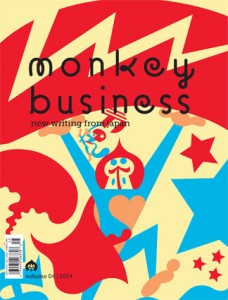
“In part, this collection is a quest. And it is a quest into questions, many of which straddle the thin lines of life, all the while hurling us through time and space, water and air, pain and pleasure, and beginnings and ends.” (A Public Space)
By Brett Rawson (Akita-ken, 2007-09) for JQ magazine. Brett is a writer, translator, and volunteer. He currently lives in New York, where he is pursuing an MFA in creative writing at The New School and is the professional development chair for the JET Alumni Association of New York. If you have job opportunities for JET alums, an interest in presenting at JETAANY’s annual Career Forum, or want to collaborate on professional endeavors, contact him at career@jetaany.org.
Meet Volume 4 of Monkey Business International: New Writings from Japan, a collection of 23 works that will take you on a wild ride through the literary landscape of Japan. In fact, it goes beyond the boundaries of Japan—as summed up by co-founders Motoyuki Shibata and Ted Goossen in the preface, Monkey Business International is “60 percent contemporary Japan, 20 percent contemporary American and British, and 20 percent modern classic Japan,” though of course not every hybrid has a categorical home.
In part, this collection is a quest. And it is a quest into questions, many of which straddle the thin lines of life, all the while hurling us through time and space, water and air, pain and pleasure, and beginnings and ends. Take for example the short story “The Man Who Turned into a Buoy” by Masatsugu Ono. The title itself seems to whisper, loosen your grip, encouraging us to suspend our disbelief and simply enjoy as our perspective gets gently nudged out of ordinary orbit.
The tale transports us to a tiny town nestled between the shoreline and the hills, which is overrun with frolicking monkeys who descend to steal food left on graves, but have been known at times to talk with villagers, and sometimes in the voice of the deceased. This town also observes the tradition of the body as a buoy—a single man tasked with the job of nakedly floating at the edge of the inlet during the day, issuing warnings to people who exit the bay. The man who turned into the buoy is the narrator’s grandfather, and his story is recounted through the grandmother in a dense dialect that is beautifully captured by translator Michael Emmerich.
JQ Magazine: Book Review — ‘Apparitions: Ghosts of Old Edo’
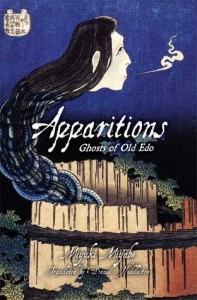
“Apparitions succeeds at not only giving historically accurate insight into the Edo period, but also delivers thought-provoking ghost stories that inspire fear and excitement with subtlety and expertly written dialogue and prose.” (Haikasoru)
By Julio Perez Jr. (Kyoto-shi, 2011-13) for JQ magazine. A bibliophile, writer, translator, and graduate from Columbia University, Julio is currently working at Ishikawa Prefecture’s New York office while seeking opportunities with publications in New York. Follow his enthusiasm for Japan, literature, and board gaming on his blog and Twitter @brittlejules.
Miyuki Miyabe is a Japanese author who writes widely popular fantasy, science fiction, and crime fiction for adults and young adults. Some of her works translated into English are Brave Story, ICO: Castle in the Mist, and The Book of Heroes. Published by Haikasoru last November, Apparitions: Ghosts of Old Edo is a collection of Miyabe’s short stories (translated by Daniel Huddleston) about pre-modern Japan depictions of ghosts, oni, and other supernatural events.
Apparitions includes nine short stories that are each unique but all so thoroughly engrossing that you can feel the immediacy of the narrator leaning in to deliver the chilling line foretelling the horrors yet to be revealed. Each of the stories captures the social hierarchy of the Edo period, which is a key element to illustrate in Japanese horror. One of the reoccurring aspects in Japanese ghost lore is an unbearably deep grudge that keeps a person’s spirit lingering after death. Edo society had a very rigid class system that is the source of frustration and resentment among characters, and this very resentment leads to vengeful ghost stories. This is why most ghosts in this genre are servants or women who are taking revenge on unjust masters, and insincere lovers of higher status. In this way, Japanese ghost stories are uniquely powerful in portraying the potential for wickedness in the human heart, whether it is the heart of the living or that of the vengeful dead. The supernatural dangers that appear in these stories all result from the cruel actions and thoughts of normal people that can and do occur every day. This is often exactly what is terrifying about these tales—not the ghosts, but the people.
JQ Magazine: Book Review – ‘Cool Japan: A Guide to Tokyo, Kyoto, Tohoku and Japanese Culture Past and Present’
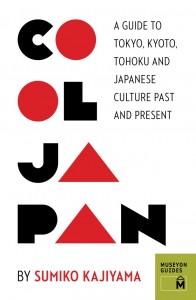
“Cool Japan focuses on giving an inside look into the enduring and captivating qualities of Japan’s culture and history and how it can be discovered by visiting Kyoto, Tokyo, and the Tohoku region.” (Museyon Guides)
By Julio Perez Jr. (Kyoto-shi, 2011-13) for JQ magazine. A bibliophile, writer, translator, and graduate from Columbia University, Julio is currently working at Ishikawa Prefecture’s New York office while seeking opportunities with publications in New York. Follow his enthusiasm for Japan, literature, and board gaming on his blog http://brittlejules.wordpress.com and Twitter @brittlejules.
When was the last time you picked up a non-fiction book and felt like you were escaping to a faraway land? Cool Japan (Museyon Guides) is the special kind of guidebook that does just that.
The author, Sumiko Kajiyama, is a journalist and scriptwriter residing in Japan. Her other books include Ghibli Magic, The Man who Changed Animation Business, The Way of Work by Top Producers, and Important Things to Enjoy Your Work and Life.
In any bookstore you will find Frommer’s, Lonely Planet, and Fodor’s travel guidebooks. You may own a few already from trips you have taken in the past. While these guides are meticulously researched and written to suit a traveler’s needs, there is an inherent problem that they all have in common: over a relatively short amount of time, prices for services or goods can change, hostels can move or go out of business, and new ones can pop up in yet undiscovered places. For these reasons, and many that need not be mentioned, the Internet has become an invaluable tool for anyone planning a trip. Many digital communities of travelers have evolved for the exchange of current information. Furthermore, smartphones allow today’s travelers to access all of this information on the go.
So you may be wondering, why buy a guidebook at all? There are many reasons to buy the ones listed above, despite the weakness of having an ever-decaying reliability of information. Cool Japan is a special because it does not squander space listing information that may no longer be relevant by the time it gets into your hands, but instead Cool Japan focuses on giving an inside look into the enduring and captivating qualities of Japan’s culture and history and how it can be discovered by visiting Kyoto, Tokyo, and the Tohoku region.
JQ Magazine: Book Review — ‘Public Properties: Museums in Imperial Japan’
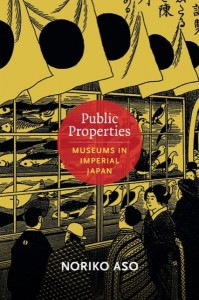
“Aso’s study is an intriguing, and refreshingly straightforward, examination of the shaping of the Japanese public in an era of increasing speed, change and modernization in the realm of how objects can promote, or even create, a national identity.” (Duke University Press)
By Jessica Sattell (Fukuoka-ken, 2007-08) for JQ magazine. Jessica is a freelance writer and a graduate student in arts journalism. Her favorite museum in all of Japan is the Fukuoka Asian Art Museum, but the Mori Art Museum is a close second.
Artist Barbara Kruger poses the pinnacle of questions in an untitled 1991 photograph and type-on-paper piece featuring a sunglasses-clad man whose mouth is twisted into a howl of wonder: “Why are you here?” She provides a few suggestions: “To kill time? To get ‘cultured’? To widen your world? To think good thoughts? To improve your social life?” When this piece is encountered within the walls of a gallery or art museum, these prompts can stir the viewer to question their place as a member of a larger conversation, rather than a simple viewer or consumer. This provokes further rumination: what do we feel when we go to museums, anywhere in the world? What connections do we have, or are we “supposed” to have, to an assortment of collected and cataloged objects arranged for public access? How are we shaped by social and political entities that can (and do) organize exhibitions around certain agendas? Design, of any kind, is never without direction.
Dr. Noriko Aso, Associate Professor of History at the University of California, Santa Cruz, addresses these, and several other powerful veins of inquiry, in her recently published book Public Properties: Museums in Imperial Japan (Duke University Press). She posits that the forerunner to the Japanese museum audience of today was shaped by governing bodies in a shift that brought state-safeguarded treasures out of storage houses and into public view. In this sense, museums in Imperial Japan (1868-1945) played a part far beyond that of the cultural repository and actually took on an active role in cultivating a Japanese national identity. Artworks, ancient artifacts and other cultural treasures helped to shape the self-representation of a self-actualized Japanese public.
JQ Magazine: Film Review—Hirokazu Kore-eda’s ‘Like Father, Like Son’
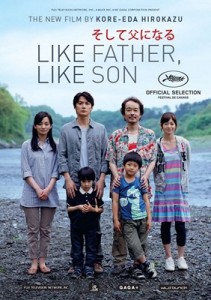
“As in his other films, Kore-eda’s action unfolds in minute detail and slowly evolving scenes. His static camera and well-balanced visual frame reference Ozu, another director concerned with Japan’s modernization and the traditional family.” (© 2013 FUJI TELEVISION NETWORK, INC.AMUSE INC.GAGA CORPORATION. All rights reserved.)
By Lyle Sylvander (Yokohama-shi, 2001-02) for JQ magazine. Lyle has completed a master’s program at the School of International and Public Affairs at Columbia University and has been writing for the JET Alumni Association of New York since 2004. He is also the goalkeeper for FC Japan, a New York City-based soccer team.
The winner of the Jury Prize at the 2013 Cannes Film Festival, Hirokazu Kore-eda’s newest film, Like Father, Like Son, features a stronger narrative arc and story than his previous films, which include the metaphysically philosophical After Life and the naturalistic Ozu-like Nobody Knows. In fact, the film’s plot reads like a Hollywood high-concept pitch: two families discover that their children are not their own due to a switch at birth. Developing a “nature vs. nurture”-type approach to the subject, Kore-eda gives the families different socioeconomic backgrounds.
Ryota Nonomiya (Masaharu Fukuyama) is a high-achieving architect who lives in a modern Tokyo high-rise apartment with his wife Midori and their six-year-old son Keita (Keita Ninomiya). The other father, Yudai Saiki (Lily Franky), is a working class shopkeeper who lives on the outskirts of the city in a nondescript housing block with his wife Yukari (Yoko Maki) and the young Ryusei (Hwang Sho-gen). By presenting these two disparate backgrounds, Kore-eda examines the nature of father-son relationships and familial influence in modern Japan.
Much of the film’s action concerns the responses to the shocking new information. Do the families try and “switch” the children again so that the original wrong can be corrected? Now that they are inseparably involved in each others’ lives, do they try and raise the children together? Or do they simply carry on as before, complicit in their knowledge that neither child is living with his biological parents? Kore-eda examines each of these scenarios as the characters try to confront a situation that life has not prepared them for.
JQ Magazine: Manga Review — ‘Showa 1926-1939: A History of Japan’
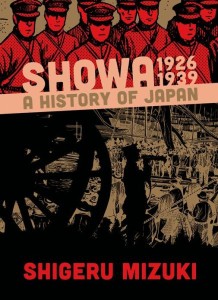
“If you enjoy or are interested in manga, history and yokai, or if you appreciate excellent works such as Barefoot Gen and Maus, then Showa 1926-1939: A History of Japan and the rest of the series is a must-read.” (Drawn and Quarterly)
By Julio Perez Jr. (Kyoto-shi, 2011-13) for JQ magazine. A bibliophile, writer, translator, and graduate from Columbia University, Julio is currently seeking opportunities with publications in New York. You can follow his enthusiasm for Japan, literature, and board gaming on Twitter @brittlejules.
Shigeru Mizuki is a world-famous manga artist and writer best known for his work on yokai, which deals with Japanese ghosts, monsters and supernatural stories. He is the creator of Ge Ge Ge no Kitaro, his most famous work about yokai, and he is also well known and respected in Japan for his autobiographical work about growing up and serving as as a soldier in World War II-era Japan. He created a well researched historical and autobiographical manga about the Showa period which received the Kodansha Manga Award in 1990 and is now being published in English by Drawn and Quarterly. The first of four volumes, Showa 1926-1939: A History of Japan, was translated by JET alum Zack Davisson (Nara-ken, 2001-04; Osaka-shi, 2004-06) and released last November. (For more on Davisson, read our exclusive JQ interview with him here.)
This illustrated history of Japan is praised for its accuracy in portraying the atrocities of the Japanese military during the Pacific War while also showing how the Japanese people themselves suffered on the home front. At 91 years old today, Mizuki has given us a complete and accurate account of an entire age that few alive today remember and that the rest never knew firsthand. The story is an important and valuable resource meant for generations of people who have not experienced the chaos of war and the despair of starvation. The manga is very much meant to educate the next generation of Japanese children about the controversial and darker parts of their history and to serve as a cautionary tale to remember in times of peace. It does not sugarcoat anything, and gives great insight into the tensions between Japan and China, North and South Korea, and other countries in Asia that persist today.
The 17th Japanese Film Festival in Australia wraps up after a mammoth tour around Australia. Eden Law (Fukushima JET 2010-2011, current member of JETAA NSW reviews some of the films that were on offer.

Is this organically-made?
This is a very Japanese melodrama, filled with messages about perseverance and dedication, themes that were common to many of this year’s film festival selection. The story of an apple farmer’s struggles to grow viable organic crops, it is actually based on a true story of Akinori Kimura and his wife Mieko Kimura, first popularized in a tv special and then a book (by the catchy title of “Kiseki no Ringo (Zettai Fukano) oh Kutsugaeshita Noka・ Akinori Kimura no Kiroku”) written about them by Takuji Ishikawa.
Son of an Aomori apple farming family, from an early age, Kimura (Sadao Abe) is shown to be an inveterate tinkerer, taking apart things to see how they work (although not so proficient on putting them back together again). Dissatisfied with the conservative and incurious mentality of his home town, he leaves for Tokyo for greater and better things, only to be ordered back to attend his own wedding arrangements to the local beauty, Mieko (Miho Kanno). Apparently this was enough to get Kimura to ditch his entire career in the city and settle down without complaints, to do the one thing he had scorned – apple farming, no doubt delighting his parents that their son is finally settling down and cleaving to his appropriate destiny. But then Kimura discovers that his young wife has a severe allergic reaction to all the chemical pesticides and fertilizers. So turning that curious tinker’s mind of his to the problem, he embarks on what will be a long and hard road to perfecting the perfect organic apple.
While the suffering and tribulations the Kimuras (they ended up having three daughters) endure are harsh, at times it seems so over the top that it veers closely into melodramatic territory. It’s hard to believe that the very young children shared in the suffering of their parents, for example, a sentiment echoed by Kimura’s best friend who at one point berate him severely for neglecting his daughter’s needs in a “selfish” pursuit of his dream. They have no electricity, nothing to eat, and Kimura has to take odd jobs in Tokyo to keep the family going, before losing it in a mugging – one disaster upon another. Abe’s portrayal of Kimura is also problematic, as the actor, whose cheerful face, while expressive enough to show a measure of unease beneath that ever-present smile, sometimes hits the wrong note and fails to convey the appropriate emotion that particular scenes call for. In these instances, Abe just seems at best a slightly confused person who knows that something is wrong but not entirely sure what, thereby lessening the emotional impact. It does admittedly, bring an extra level of tragedy to Kanno’s role as the long-suffering wife, who for whatever reason, continuously supports her husband through thick and thin; her acting range is decidedly broader and richer in depth. Tsutomu Yamazaki, as the wise father-in-law, in contrast, radiates such presence and dignity without having to do very much that he threatens to steal every scene he’s in. He’s the kind of strong, silent parental type that everyone wishes they have in real life.
However, it’s undeniable that it is quite a compelling story, and the Kimuras are such sympathetic characters that you can’t help but become invested in their struggles. The locations are extraordinarily beautiful, with Mt Iwaki in the background. And while I can’t be sure, I think the dialogue were spoken in Tohoku dialect, a delightful detail since I had lived in Tohoku for a time, and it certainly reinforces the bucolic country setting. Chosen to close the 17th Japanese Film Festival, it is an appropriate choice that echoes the festival’s theme of discipline, endurance and cooperation.
Fruits of Faith (Kiseki no Ringo) by Yoshihiro Nakamura, released June 8 2013 in Japan, starring Sadao Abe, Miho Kanno, Hiroyuki Ikeuchi, Takashi Sasano, Masato Ibu, Mieko Harada and Tsutomu Yamazaki.
The 17th Japanese Film Festival in Australia is now showing in Melbourne, the last major city on its national tour before wrapping up for the year. Eden Law (Fukushima JET 2010-2011, current member of JETAA NSW reviews some of the films on offer.

I said SHUSH MF!! * machine gun fire *
Library Wars (Toshokan Senso) is the latest in a series of adaptation of an extremely popular series of light novels by Hiro Arikawa, which has included your usual manga and anime. The inspiration for the plot comes from the real life Statement on Intellectual Freedom in Libraries of the Japan Library Association, which kind of sounds pretty bad-ass when you think about it. Especially when, interpreting its mission statement rather liberally to mean the right to bear arms. Armed librarians. Hate to think what the penalties for late returns would be.
Dealing with the theme of censorship, Japan in an alternate reality has gone overboard with outlawing ‘unsuitable’ reading material, raiding shops with maniacal book-burning zeal. But against this thought police are the librarians who form the defensive Librarian force, who take up arms to protect the citizens’ right and access to information. Joining the ranks is Iku Kasahara (Nana Eikura), who is your typical rough diamond – brash, impulsive, klutzy, a rule-breaker and therefore audience favourite. She continuously butts head against hard-arse Atsushi Dojo (Junichi Okada), a no-nonsense senior librarian who naturally, questions her place in the force. Around them, forces are on the move to consolidate and destroy books and knowledge, and the Library Force gears up for the ultimate confrontation.
This isn’t Fahrenheit 451, although there are some discussions about freedom of speech and an out of control state that doesn’t know where to draw the line in the name of protecting the hearts and minds of the nation from indecency and corruption. But for the most part, it’s largely kept light and focused on comedy and action, with recognizable character tropes from Japanese fiction. While it’s a pure escapism, some things are a bit far-fetched: you wonder why no one, in the year 2019, have thought about making backups, especially if these things are so precious, for example.
The cast perform their roles as expected, their characters doesn’t have much need for complex character development. Things like character quirks that might work in a novel or an anime situation don’t translate too well into a live-action film – Kasahara’s personality isn’t that endearing, and Dojo, as handsome as he is, is rather a one-note character. There’s obviously a lot that hasn’t been transferred from a wealth of source material into the short timeframe of a film. Although I must say Jun Hashimoto’s scenery chewing is one of the entertaining things to watch in this film (it’s like each facial muscle is working independently of each other). Things pick up in the last half as it’s action-packed, but the film is largely froth and would appeal the most to the fan base. Had it been a lot funnier, I might be more forgiving of some of the plot holes, but as such, while it isn’t bad, it’s just rather pedestrian and unmemorable.
Library Wars (Toshokan Senso) by Shinsuke Sato, released April 27 2013 in Japan, starring Junichi Okada, Nana Eikura, Kei Tanaka, Sota Fukushi, Chiaki Kuriyama, Kenji Takeyama, Iwao Nishina, Ryusuke Kenta and Maki Orikuchi.
The 17th Japanese Film Festival in Australia is now showing in Melbourne, the last major city on its national tour before wrapping up for the year. Eden Law (Fukushima JET 2010-2011, current member of JETAA NSW reviews some of the films on offer.

Will the real Hitoshi please stand up, please stand up?
This is film messed with my head. Escalating from a quirky, comedy of errors with eccentric characters to a disturbing, confusing movie where you feel like the character Hitoshi himself, running around wild-eyed in panic as you try to make sense of what’s going on – not that the film gives you any concrete answers.
But let’s start with a bit of a background. Hitoshi (Kazuya Kamenashi), a failed photographer, makes a living working in an electronics department, with fellow employees who are probably a little bit insane. Then one day, a stranger’s phone falls into his hands, and on impulse, Hitoshi takes the phone and scams the owner’s mother into depositing 900,000 yen into his bank account. And then that’s when shit gets weird.
The title “It’s Me, It’s Me” comes from the fact Hitoshi starts finding copies of himself popping up, each with his face but different name, different lifestyles – even of the opposite gender. It’s almost like seeing versions of himself – Kamenashi doesn’t just wear different wigs or clothes, or act differently; his face gets superimposed on wildly different body types like that scene from Being John Malkovich. Does each copy represent a possibility or alternate reality that could have been, had circumstances being different, or a choice decided in another way? Which is the real Hitoshi? Was there ever a real Hitoshi? I really don’t know – you tell me. At first finding other “me”s is fun – it’s like finding someone who truly understands you – but the initial novelty and fun of first discovery soon gives way to darker developments, as the initial group of Hitoshis realise that not every aspect of their personality is pleasant, or even desirable. Out of place objects then begin to appear in some scenes, such as overturned drums of strange viscous pink liquid crop up and disappear, posters of a pair of eyes stuck on walls appear to watch Hitoshi and his strange adventures – Miki’s mischievous and anarchic humour teases us as they appear and disappear in the film, like visual signposts of the upcoming weirdness that is about to unleash.
But in the meantime, we are distracted by the anarchic humour and fun by the assortment of characters and dialogue. Minor characters are invested with a huge amount of personality and energy, like Hitoshi’s original mum, Masae (Midoriko Kimura) who insists on being called by her name instead of “mother” because she decided it suits her more; his co-workers like the hyperactive Minami (Eri Fuse) and overbearing dorky manager Tajime (Ryo Kase) and sexy customer Sayaka (Yuki Uchida). Kamenashi juggles a huge amount of roles, portraying different minor characters who seem to be different kind of Japanese stereotypes, definitely working hard for his money.
You might find “Ore Ore” infuriating or intriguing, but it is a wild ride, throwing up all sorts of puzzling questions and frustrating vague hints as to the possible answers.
It’s Me, It’s Me (Ore Ore) by Satoshi Miki, released May 25th 2013 in Japan. Starring Kazuya Kamenashi, Yuki Uchida, Ryo Kase, Midoriko Kimura, Keiko Takahashi, Eri Fuse, Ryu Nakatani and Kinako Kobayashi.
JQ Magazine: Book Review – ‘Life in Japan: The First Year’
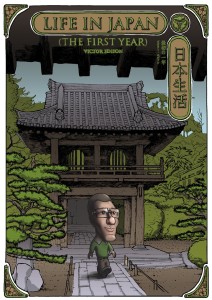
“Edison’s artistic talent captures Japan’s essence and his autobiographical account is honest and direct. JET Alumni will be able to follow his story and find many of their own experiences and thoughts represented within his work. From his first encounter ordering a hamburger to his dissatisfaction with being a glorified babysitter, his tone and pace keeps the reader hooked.” (Big Ugly Robot Publishing)
By Lana Kitcher (Yamanashi-ken, 2010-12) for JQ magazine. Lana is the business development associate for Bridges to Japan. To read more about Lana’s adventures in Japan and New York, visit her blog at Kitcher’s Café.
Victor Edison is a young man who remembers always having some Japanese influences present throughout his life. His family hosted a Japanese exchange student during his childhood, and he was fascinated by anime and manga from a young age. After graduation he found himself working a job he didn’t really want that wasn’t really going anywhere. A friend that was working in Japan at the time encouraged him to apply to be an English teacher and all he could respond to this was, “why not?”
Published by Nagoya-based Big Ugly Robot Press, Life in Japan: The First Year is a bilingual graphic novel written and drawn by Edison about his first year working for an English language school in Mie Prefecture. With little previous knowledge of the Japanese language or customs, he travels blindly to his new home armed only with his enthusiasm and determination to succeed, his ultimate goal to one day become a full-time artist.
His first choice was to work in Tokyo, simply because that was all he knew. After his interview with “Noba,” he soon learns that he has been offered a position in Mie, and accepts.
He starts work at an English conversation school located in a semi-rural area. While the majority of the clients were adults and young adults, the teachers often had to “teach” toddler classes as well. Because the school was located in a shopping mall, many parents would drop their kids off at the English school to fit in some uninterrupted shopping time. The teachers quickly learned that the child classes were thinly disguised babysitting sessions.
The 17th Japanese Film Festival makes its final stop in Melbourne. Eden Law (Fukushima JET 2010-2011, JETAA NSW member) reviews some of the selection available.
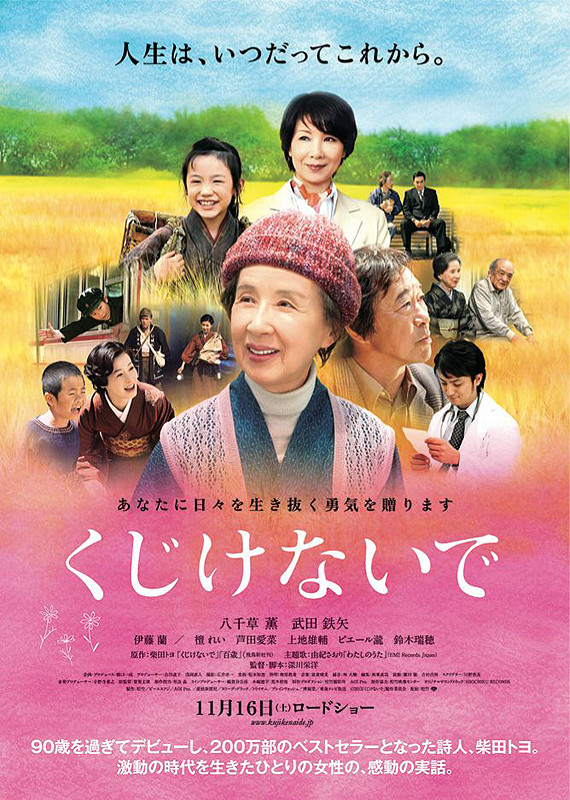
So what have you done with your life lately?
Proving its never too late to start anything, at the age of 98, Toyo Shibata sold over 1.5 million copies of her poetry collection in Japan, later achieving international fame in Asia and Europe. Shown at Australia’s national 17th Japanese Film Festival a mere week after its release in Japan, “Don’t Lose Heart”, is the film inspired by Toyo’s life and her poetry. Its international premier in Sydney was also accompanied by both the visiting director Yoshihiro Fukagawa, and the main star who plays Toyo, Kaoru Yachigusa, a legendary name in Japanese cinema.
Up until the time Toyo received recognition of her work, she lived a typical, seemingly unremarkable life as a elderly member of Japan’s rapidly aging population: a widow who lives alone, with one surviving son, Kenichi (Tetsuya Takeda) , an unreliable, chronic gambler who is terminally unemployed and financially supported by his exasperated but ultimately loving wife, Shizuko (Ran Ito). Worried about the mental state of his mother, and feeling guilty about what a big loser he is, Kenichi writes poetry with her as away of spending more time together, which eventually brought out her literary talents.
Films which contain roles for older actors are rare, and as Yachigusa said during the Q&A after the movie’s screening in Sydney, good roles are even rarer still. Yachigusa has the challenge of developing Toyo as being more than just another grannie. At first Toyo seems pitiful – she is beset by the usual ills that advanced age brings, finding it difficult to move around pain-free without a walking stick. She seems a little bland, quiet and unremarkable. However when she begins to write, the film shifts into exploring the source of her inspiration, in flashbacks that regress further and further into time. “Don’t Lose Heart” is certainly aptly named, as Toyo, in her quiet way, reaches out to counsel those around her with the benefit of her experience. By the end, Toyo is revealed to be anything but ordinary. Being alive is a pretty difficult gig for anyone, and Toyo proves she’s just as tough a chick as any fictional superhero, and more inspiring than any easily digestible soundbite artificially manufactured by cynical corporations to move units.
Yachigusa is just extraordinary in her performance. Her Toyo is dignified and gentle, but with a hint of impish mischief that shows a quick and intelligent mind is alive and well – quite similar to Yachigusa herself in the interview. She gives Toyo vulnerability and frailty, but is able to convey the fighter and survivor beneath the exterior, and the resulting sense of compassion and understanding of human nature gained from having being through it all herself. Takeda plays Kenichi as a petulant short-tempered man-child, a bit over the top maybe (you have to wonder what the real Kenichi thought of his on-screen portrayal) but possessing of the same compassionate basic nature of his mother. And as Kenichi’s wife, Ito is also superb, displaying the patience of a saint in staying with him all through the years.
Be warned: this film moved Sydney audience to tears, rather loudly too, perhaps because Toyo seemed like the kind of grandmother everyone wishes they have (unfortunately Japan’s national grandmother passed away earlier this year at the age of 101). Fukagawa said that her poetry gained prominence because of their simplicity and lack of pretension and their inherent optimism and positivity, qualities that he tries to convey in his film. He can be rather sentimental at times, imparting an almost saintly, Buddha-like glow on Toyo by the end of the film, but there is a lot of respect for the source material in this film, and it shows, resulting in a tender, tribute to not just Toyo’s writings, but to the human condition itself.
Don’t Lose Heart (Kujikenaide) by Yoshihiro Fukagawa, released November 16 2013 in Japan. Starring Kaoru Yachigusa, Tetsuya Takeda, Ran Ito, Mizuho Suzuki and Yusuke Kamiji.
As Australia’s 17th Japanese Film Festival is begins its last city tour in Melbourne, the capital of the southern state of Victoria, Eden Law (Fukushima-ken ALT 2010-2011, current JETAA NSW committee member) reviews some of what is on offer. Stay tune for more reviews!
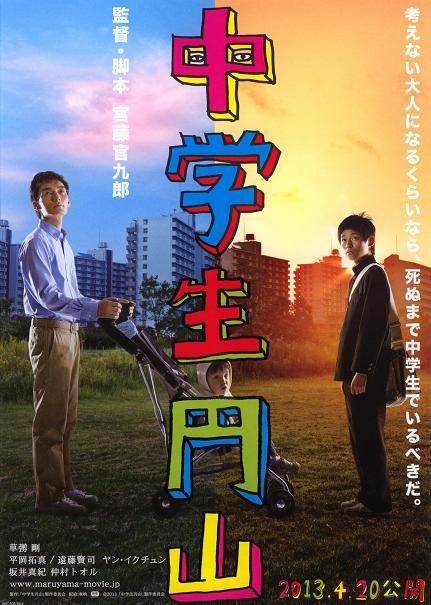
Everyone’s feeling somewhat uncomfortable now.
Okay, so what would you think if I told you that Maruyama, the main character in this film, spends most of the film trying to touch tongue to his own peen? A certain expectation will be set, wouldn’t it? Like, there wouldn’t be much else to expect from the plot except whether that lollypop gets licked. So it’s pleasantly surprising to find that it’s actually less like a string of dick jokes (unlike this review), and more of an endearingly quirky film.
Our hero with a quest, Maruyama, is a hormonal 14-year-old with a rather active imagination, frequently dreaming up imagined lives for his family and residents of his apartment complex. We’re taken through his daydreams, which range from randy fantasies filled with bouncy ladies, to colourful scenarios that get sillier and funnier as he imagines various people being either wacky fruit-themed superheroes, scissor-wielding gangsters or aliens. But Maruyama decides that he needs a hobby to distract him from such childish preoccupations, one that will bring focus and maturity – like attempting to orally do one’s own dong. However, he later befriends a dorky, uncharismatic single father, Shimoi (played with surprising ability by Tsuyoshi Kusanagi, a member of the ageless Japanese boy band SMAP), who encourages him to embrace his fantasies. Real life can be more strange than any fantasy, and a bit of strangeness is nothing to be ashamed of, but celebrated.
Maruyama’s world is undeniably ridiculous and entertaining (and sometimes sticky) as the imagination of a teen could be. And despite Maruyama’s overarching ambition to boldly try what many men have tried before (and failed, and the few that do make a career out of it), a sweet, innocent quality exists, thanks to director Kankuro Kudo’s affectionate treatment of him and all the eccentric and flawed characters that populate the neighbourhood. It’s quite an accomplishment that “Maruyama” manages to build a more substantial film on such an unlikely basis, and it results in a film that’s like a funnier combination of a Wes Andersen and Michel Gondry movie. Hiraoka Takuma, being close to the age of the character Maruyama that he plays, embodies the innocence and determined Maruyama well, shining with youthful enthusiasm, embarrassment and determination as he takes his character from zero to hero. The whole ensemble cast is perfect in their various roles, obviously having a lot of fun, from Kenji Endo’s geriatric grandfather with a surprising ability, and Maki Sakai as Maruyama’s Korean drama-obsessed mother.
It’s hard for any film to sustain the initial novelty of the first half right to the end, and “Maruyama” suffers the same problem as it gets a bit flaccid towards the end. However, the film still climaxes in a satisfactory way that, while lacking in the same vigor and energy of the start, manages to tie up all the plot threads and situations. While “Maruyama’s” length is a bit too long for comfort, overall, it charms with its humor and originality – not bad for a film that started off with auto-fellatio.
Maruyama the Middle Schooler (Chuugakusei Maruyama) by Kankuro Kudo, released in Japan April 21 2013, starring Tsuyoshi Kusanagi, Hiraoka Takuma, Kenji Endo, Yang Ik-June, Maki Sakai, Toru Nakamura, Nanami Nabemoto, Yuiko Kariya


